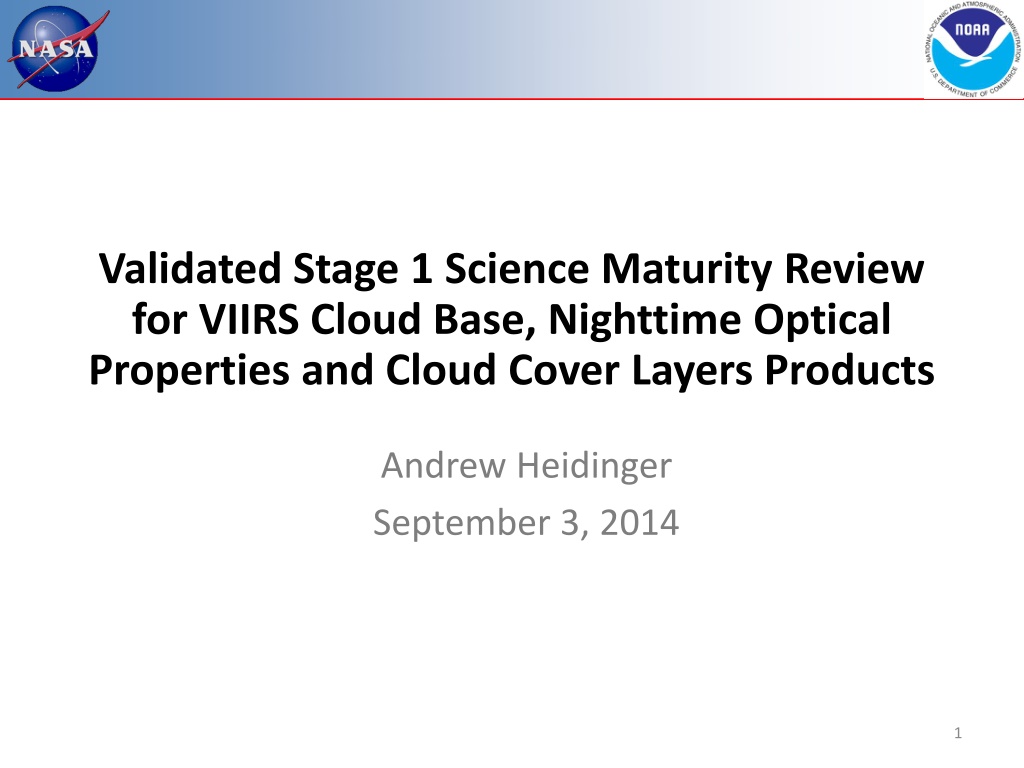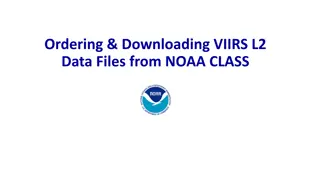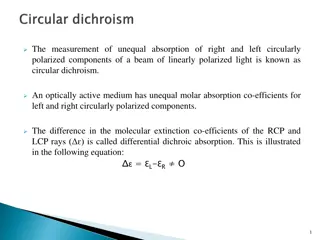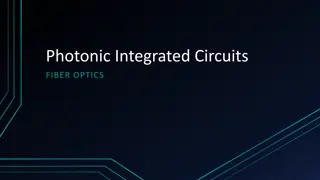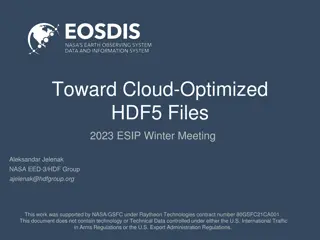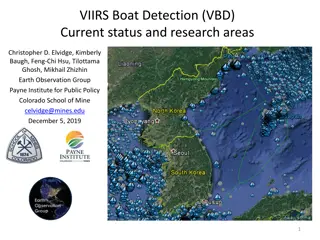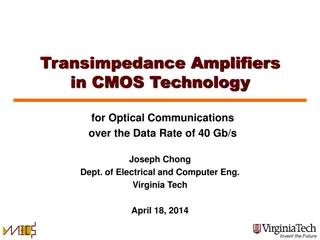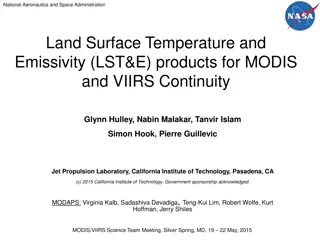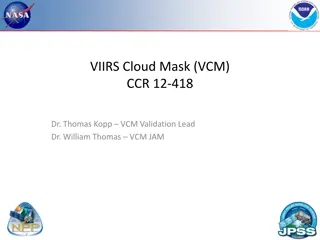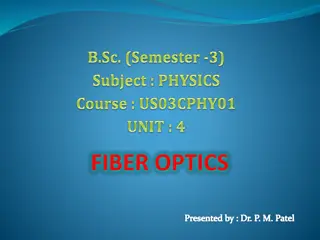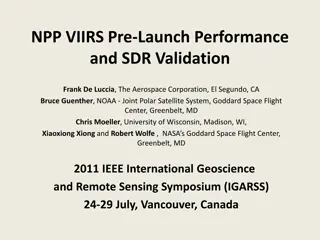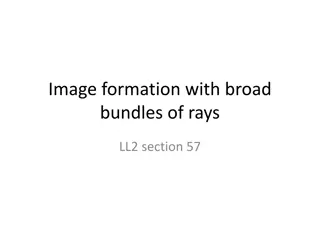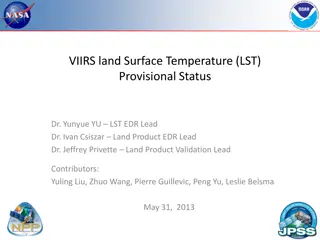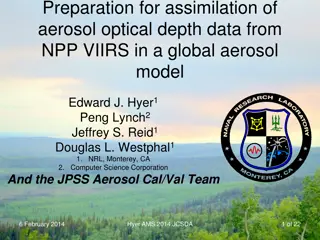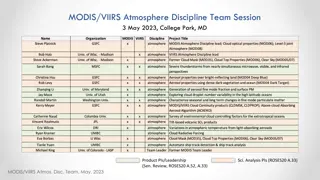VIIRS Cloud Base & Optical Properties Review
In this review, Andrew Heidinger evaluates the maturity of VIIRS Cloud Base, Nighttime Optical Properties, and Cloud Cover Layers products. The assessment includes requirements, algorithm performance, error budget, and issues hindering Stage 1 maturity. The analysis covers Cloud Base Height, Nighttime Optical Properties, and Microphysical Properties. Curtis Seamen's contribution from CIRA on Cloud Base is also highlighted. The review examines error budget based on VIIRS co-locations with CloudSat CPR data. Detailed insights into Cloud Base Height and supporting analysis are provided, showcasing the Cloud Profiling Radar's role in understanding cloud vertical structure. The evaluation extends to Nighttime Cloud Optical Properties and their corresponding requirements.
Download Presentation

Please find below an Image/Link to download the presentation.
The content on the website is provided AS IS for your information and personal use only. It may not be sold, licensed, or shared on other websites without obtaining consent from the author.If you encounter any issues during the download, it is possible that the publisher has removed the file from their server.
You are allowed to download the files provided on this website for personal or commercial use, subject to the condition that they are used lawfully. All files are the property of their respective owners.
The content on the website is provided AS IS for your information and personal use only. It may not be sold, licensed, or shared on other websites without obtaining consent from the author.
E N D
Presentation Transcript
Validated Stage 1 Science Maturity Review for VIIRS Cloud Base, Nighttime Optical Properties and Cloud Cover Layers Products Andrew Heidinger September 3, 2014 1
Outline Cloud Base Height Product Requirements Evaluation of algorithm performance to specification requirements Evaluation of the effect of required algorithm inputs Quality flag analysis/validation Error Budget Nighttime Optical and Microphysical Properties Product Requirements Issues preventing Val Stage 1 Maturity Cloud Cover Layers Product Requirements Issues with definition in NDE Conclusion Path Forward 2
Curtis Seamen, CIRA CLOUD BASE 3
Cloud Base Height Error Budget Based on VIIRS co-locations with CloudSat CPR data. Data for separated for all clouds and those that meet the CTH specification. Attribute Analyzed L1RD Threshold Analysis/Validation Result Error Summary CBH 2 km uncertainty 0.3 km and 40% of time All clouds CBH 2 km uncertainty -0.1 km and 70 % of time Clouds with CTH within spec 5
Cloud Base Height Error Budget Supporting Material and Analysis The Cloud Profiling Radar (CPR) on the NASA CloudSat Mission provides the most complete cloud vertical structure information. We define Cloud Base Height as the height of the lowest cloud layer. Distribution shows results where CTH was in spec. CBH is based on CTH. 6
Cloud Base Height Error Budget Supporting Material and Analysis Same analysis as previous slide but show as a bias histogram. Colors denote optical thickness. The specification calls for an uncertainty of 2 km. NDE is approach is similar to IDPS but new improvements are coming based on CloudSat tuning . 7
NIGHTTIME CLOUD OPTICAL PROPERTIES 8
Cloud Optical Depth Requirements No difference from Day Requirements shown earlier 9
Cloud Effective Particle Size Requirements No difference from Day Requirements shown earlier 10
Nighttime Cloud Optical and Microphysical Product Issues NDE is implementing the GOES-R version (NCOMP) which comes from Dr. Patrick Minnis of NASA LaRC. This algorithm does not run in CLAVR-x and we can t yet run it in the NDE SAPF. Therefore we can t assess its maturity on VIIRS. NCOMP will undergo an NDE review later this year and this material should be relevant for the JPSS maturity assessment. IDPS products never made it to Provisional. 11
Cloud Cover Layers Issues NDE is implementing the GOES-R version which is simply the cloud fraction for the high, middle and low cloud layers. The JPSS Cloud Cover Layers dynamically finds the layers based on binning. The performance of both of these is totally dependent on the CTP algorithm. Either way is not a technical problem. Bill Ward has communicated interest for CCL over Hawaii and we work with him to gauge NWS interest. 14
Identification of Processing Environment All algorithms shown here have been delivered to and implemented in the STAR Algorithm Processing Framework (SAPF). Algorithm Version = First Delivery to SAPF (number unknown). Version of LUTs : First Delivery to SAPF Version of PCTs: Not Applicable Description of environment used to achieve validated stage 1 All results shown here were generated with CLAVR-x version 5.4 CLAVR-x runs within CSPP (VIIRS, MODIS and AVHRR) CLAVR-x runs in OSPO though only on AVHRR and GOES CLAVR-x does not run the Night Cloud Optical Properties CLAVR-x does not run the NDE Cloud Phase/Type Algorithm. The official IDPS VCM including Cloud Phase were used in this analysis. CLAVR-x has the ability to read those in before generated downstream cloud products. 15
Users & User Feedback User Feedback NDE Algorithms Released in CSPP. Most feedback and interaction has been with training users on the product definitions and use of quality flags. Taiwan Weather Service has given most feedback. EUMETSAT has been served CTH since January no feedback yet. Bill Ward expressed interest Cloud Cover Layers over Hawaii. Downstream product list Polar Winds (CTH used in height assignment) Reports from downstream product teams on the dependencies and impacts None received for IDPS or NDE algorithms yet. 16
Conclusion Team does not recommend algorithm validated stage 1 maturity yet for Cloud Base While the cloud base performs better than IDPS version, we still think we need development to make a useful product. This development is on-going and should yield a mature product in 6 months. Should we adopt GOES-R L1 Requirements? Team can not make a decision on the maturity of the following Nighttime Cloud Optical Properties This algorithm is recently implemented into NDE SAPF. We do not have the ability to run it yet. GOES-R version would meet specs. Cloud Cover Layers NDE Cloud Cover Layers has a different (simpler) definition than JPSS. The algorithm is simple and driven by Cloud Top Parameters. We recommend implemented IDPS-like Cloud Cover Layers into NDE. Alternatively, we adopt simpler GOES-R definition 17
Path Forward Planned further improvements cloud base Finalize CloudSat derived parameterizations of geometrical thickness. Finalize use of NWP profiles for thick clouds. Implement IDPS-like cloud cover layers (if directed). Planned Cal/Val activities / milestones Validate Nighttime COP when available from NDE SAPF Launch our CALIPSO and MODIS near-real time monitoring site. Draft reports on impacts of cloud type and cloud mask errors on cloud product performance. 18
